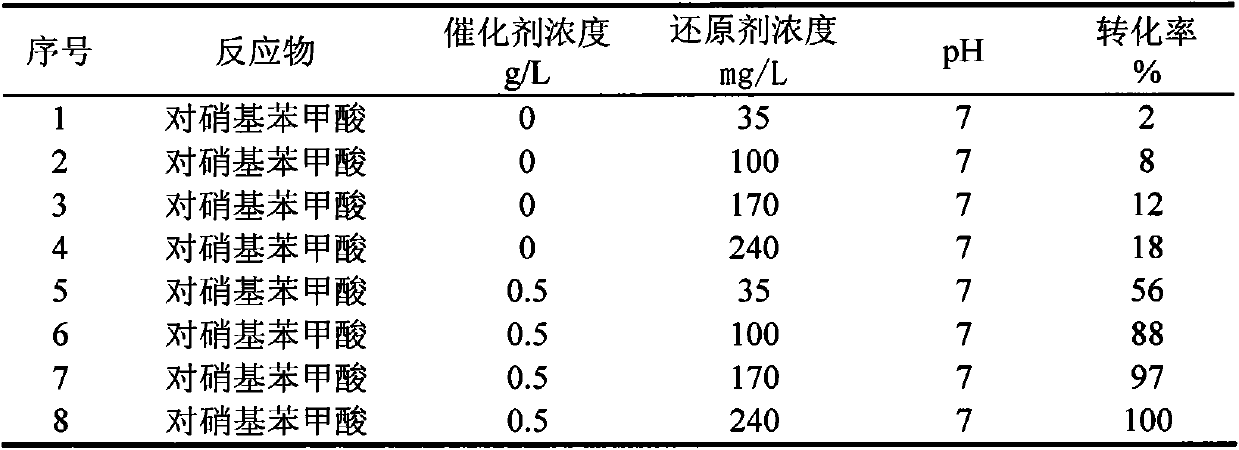Method for treating p-nitrobenzoic acid wastewater with activated carbon through catalytic reduction
A technology of p-nitrobenzoic acid and activated carbon, applied in the direction of reduced water/sewage treatment, chemical instruments and methods, water/sludge/sewage treatment, etc., to achieve low requirements for reaction equipment, cost saving, and simple and easy methods Effect
- Summary
- Abstract
- Description
- Claims
- Application Information
AI Technical Summary
Problems solved by technology
Method used
Image
Examples
Embodiment 1
[0023] Embodiment 1: Sodium thiosulfate reduces p-nitrobenzoic acid wastewater
[0024] In 8 1L anaerobic simulated reactors, adding pH is 7 phosphate buffer solution and concentration is the p-nitrobenzoic acid waste water of 30mg / L, is filled with high-purity nitrogen (to remove the nitrogen in the reaction system) in the reactor. Oxygen, form anaerobic environment), add 35mg / L, 100mg / L, 170mg / L, 240mg / L reducing agent sodium thiosulfate solution respectively in the reactor, then, do not add catalyst in No. 1-4 reactor, In No. 5-8 reactor, add 0.5g gac respectively (make its concentration be 0.5g / L) as reaction catalyst. The reactor is sealed and placed in a rotary oscillator, and the reaction is shaken at a speed of 150-200 rpm at normal temperature and pressure for 48 hours. After the reaction, the reduced product is p-aminobenzoic acid. The conversion rate of p-nitrobenzoic acid is shown in Table 1.
[0025] Table 1 Conversion rate of p-nitrobenzoic acid under sodium th...
Embodiment 2
[0027] Embodiment 2: Reductive conversion of p-nitrobenzoic acid under different catalyst concentration conditions
[0028] Different from Example 1, in 5 reactors, add respectively the reducing agent sodium thiosulfate solution of 100mg / L, then, add a certain amount of activated carbon (making its concentration be 0.1,0.3,0.5, 0.7, 1.0g / L) as the reaction catalyst. The reactor was sealed and placed in a rotary shaker, and the reaction was shaken at a speed of 150-200 rpm at normal temperature and pressure for 48 hours. The conversion rate of p-nitrobenzoic acid is shown in Table 2.
[0029] Table 2 Reductive transformation of p-nitrobenzoic acid under different catalyst concentrations
[0030]
Embodiment 3
[0031] Embodiment 3: the reductive transformation of p-nitrobenzoic acid when catalyst is reused
[0032] Different from Example 1, in 5 reactors, add respectively the reducing agent sodium thiosulfate solution of 170mg / L; 4, 6, 8 times) as a reaction catalyst. The reactor was sealed and placed in a rotary shaker, and the reaction was shaken at a speed of 150-200 rpm at normal temperature and pressure for 48 hours. The conversion rate of p-nitrobenzoic acid is shown in Table 3.
[0033] Table 3 Reductive transformation of p-nitrobenzoic acid under different catalyst concentrations
[0034]
PUM
 Login to View More
Login to View More Abstract
Description
Claims
Application Information
 Login to View More
Login to View More - R&D
- Intellectual Property
- Life Sciences
- Materials
- Tech Scout
- Unparalleled Data Quality
- Higher Quality Content
- 60% Fewer Hallucinations
Browse by: Latest US Patents, China's latest patents, Technical Efficacy Thesaurus, Application Domain, Technology Topic, Popular Technical Reports.
© 2025 PatSnap. All rights reserved.Legal|Privacy policy|Modern Slavery Act Transparency Statement|Sitemap|About US| Contact US: help@patsnap.com



